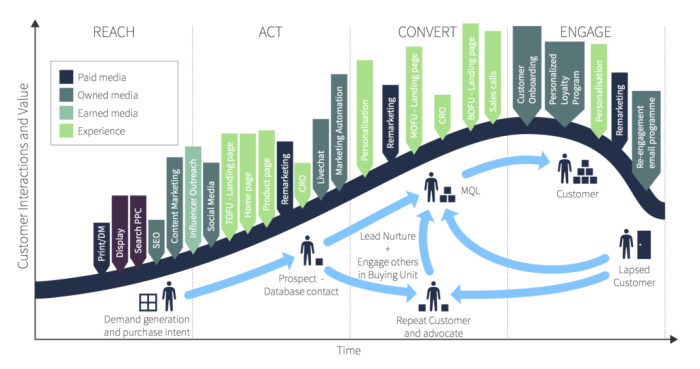Building a Multi-Channel Marketing Plan takes center stage, drawing you into a world of strategic marketing prowess. Get ready to dive deep into the realm of multi-channel strategies that can elevate your business to new heights.
From understanding the importance of multi-channel marketing to implementing and managing campaigns seamlessly, this comprehensive guide will equip you with the tools needed to thrive in today’s competitive landscape.
Importance of Multi-Channel Marketing: Building A Multi-Channel Marketing Plan

Multi-channel marketing is essential for businesses in today’s digital age as it allows companies to reach customers through various platforms and channels. This approach not only increases brand visibility but also enables businesses to engage with customers at different touchpoints throughout their buying journey.
Examples of Successful Multi-Channel Marketing Strategies
- Omni-Channel Integration: Companies like Starbucks have successfully integrated their online and offline channels, allowing customers to order and pay through their app, website, or in-store.
- Social Media Engagement: Brands like Nike use social media platforms like Instagram, Twitter, and Facebook to connect with their audience, share content, and drive traffic to their website.
- Email Marketing Campaigns: Retailers like Amazon use personalized email campaigns to target customers based on their browsing history, purchase behavior, and preferences.
How Multi-Channel Marketing Improves Customer Engagement
- Enhanced Customer Experience: By being present on various channels, businesses can provide a seamless and consistent experience to customers, leading to increased satisfaction and loyalty.
- Increased Reach: Multi-channel marketing allows businesses to reach a wider audience and target different customer segments effectively, resulting in higher brand awareness and engagement.
- Data-Driven Insights: By utilizing multiple channels, businesses can gather valuable data on customer behavior and preferences, enabling them to tailor their marketing strategies for better engagement and conversion rates.
Developing a Multi-Channel Marketing Plan

Creating a comprehensive multi-channel marketing plan involves several key steps to ensure a cohesive and effective strategy across various platforms.
Identifying the Target Audience for Each Channel
- Research and analyze customer demographics, behaviors, and preferences to understand which channels they use most frequently.
- Create buyer personas to represent different segments of your target audience and tailor messaging accordingly.
- Utilize data analytics and tracking tools to monitor customer interactions and engagement on each channel.
Aligning Messaging Across Different Channels
- Develop a consistent brand voice and messaging strategy that can be adapted to suit the unique characteristics of each channel.
- Ensure that key brand messaging and value propositions are communicated consistently across all channels to maintain brand integrity.
- Utilize integrated marketing communication techniques to ensure a seamless transition between channels for the customer.
Choosing the Right Channels
In building a multi-channel marketing plan, it’s crucial to carefully choose the right channels to reach your target audience effectively. By selecting the most suitable marketing channels, you can maximize your reach and engagement with potential customers.
Comparing Different Marketing Channels
When deciding on the marketing channels to include in your multi-channel plan, it’s essential to compare the strengths and weaknesses of each option. Social media platforms like Facebook, Instagram, and Twitter are great for reaching a broad audience and fostering engagement. Email marketing is effective for personalized communication and nurturing leads. (Search Engine Optimization) helps improve your online visibility and drives organic traffic to your website.
- Social Media: Offers a wide reach and engagement opportunities.
- Email Marketing: Enables personalized communication and lead nurturing.
- : Enhances online visibility and drives organic traffic.
Selecting Channels Based on Target Audience’s Preferences
To choose the right channels for your multi-channel marketing plan, consider your target audience’s preferences and behaviors. Conduct market research to understand where your audience spends their time online and how they prefer to interact with brands. Tailor your channel selection to align with these preferences to maximize the impact of your marketing efforts.
Understanding your target audience is key to selecting the most effective marketing channels.
Integrating Online and Offline Channels Effectively, Building a Multi-Channel Marketing Plan
Integrating online and offline channels can create a seamless and cohesive customer experience. Consider how you can bridge the gap between digital and traditional marketing channels to provide a holistic brand experience. For example, you can use QR codes on offline marketing materials to drive traffic to your website or encourage in-store visits through online promotions.
- Use QR codes to connect offline and online marketing efforts.
- Offer online promotions to drive traffic to physical stores.
- Ensure consistency in branding and messaging across all channels.
Implementing and Managing Multi-Channel Campaigns
When it comes to coordinating campaigns across various channels, it’s crucial to have a well-thought-out plan in place. This involves ensuring consistent messaging and branding while tailoring content to suit the specific platform.
Coordinating Campaigns Across Channels
- Establish a central hub for campaign management to track progress and ensure consistency.
- Utilize automation tools to streamline processes and maintain a unified message.
- Assign clear roles and responsibilities to team members to avoid confusion and overlap.
Tracking and Measuring Success
- Set specific KPIs for each channel to gauge performance and make data-driven decisions.
- Utilize analytics tools to monitor engagement, conversions, and ROI across all channels.
- Regularly analyze data to identify trends and optimize campaigns for better results.
Importance of Consistency in Branding
- Consistent branding helps build trust and recognition among your target audience.
- Uniform messaging across channels reinforces brand identity and values.
- Ensure all visual elements align with your brand guidelines to maintain a cohesive look and feel.